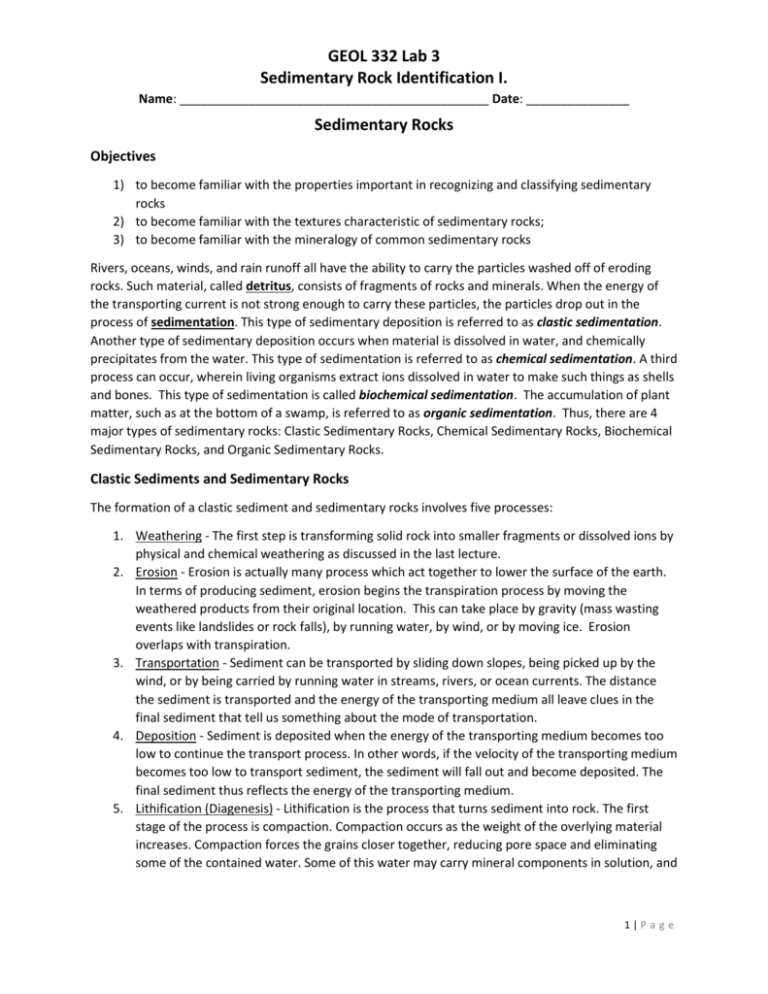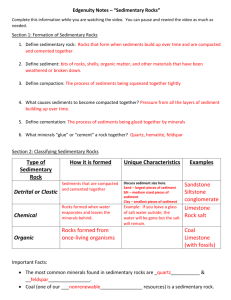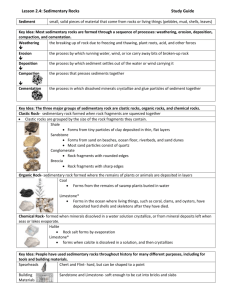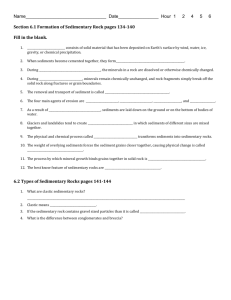GEOL_332_lab_03_hand..
advertisement

GEOL 332 Lab 3 Sedimentary Rock Identification I. Name: _____________________________________________ Date: _______________ Sedimentary Rocks Objectives 1) to become familiar with the properties important in recognizing and classifying sedimentary rocks 2) to become familiar with the textures characteristic of sedimentary rocks; 3) to become familiar with the mineralogy of common sedimentary rocks Rivers, oceans, winds, and rain runoff all have the ability to carry the particles washed off of eroding rocks. Such material, called detritus, consists of fragments of rocks and minerals. When the energy of the transporting current is not strong enough to carry these particles, the particles drop out in the process of sedimentation. This type of sedimentary deposition is referred to as clastic sedimentation. Another type of sedimentary deposition occurs when material is dissolved in water, and chemically precipitates from the water. This type of sedimentation is referred to as chemical sedimentation. A third process can occur, wherein living organisms extract ions dissolved in water to make such things as shells and bones. This type of sedimentation is called biochemical sedimentation. The accumulation of plant matter, such as at the bottom of a swamp, is referred to as organic sedimentation. Thus, there are 4 major types of sedimentary rocks: Clastic Sedimentary Rocks, Chemical Sedimentary Rocks, Biochemical Sedimentary Rocks, and Organic Sedimentary Rocks. Clastic Sediments and Sedimentary Rocks The formation of a clastic sediment and sedimentary rocks involves five processes: 1. Weathering - The first step is transforming solid rock into smaller fragments or dissolved ions by physical and chemical weathering as discussed in the last lecture. 2. Erosion - Erosion is actually many process which act together to lower the surface of the earth. In terms of producing sediment, erosion begins the transpiration process by moving the weathered products from their original location. This can take place by gravity (mass wasting events like landslides or rock falls), by running water, by wind, or by moving ice. Erosion overlaps with transpiration. 3. Transportation - Sediment can be transported by sliding down slopes, being picked up by the wind, or by being carried by running water in streams, rivers, or ocean currents. The distance the sediment is transported and the energy of the transporting medium all leave clues in the final sediment that tell us something about the mode of transportation. 4. Deposition - Sediment is deposited when the energy of the transporting medium becomes too low to continue the transport process. In other words, if the velocity of the transporting medium becomes too low to transport sediment, the sediment will fall out and become deposited. The final sediment thus reflects the energy of the transporting medium. 5. Lithification (Diagenesis) - Lithification is the process that turns sediment into rock. The first stage of the process is compaction. Compaction occurs as the weight of the overlying material increases. Compaction forces the grains closer together, reducing pore space and eliminating some of the contained water. Some of this water may carry mineral components in solution, and 1|P a g e GEOL 332 Lab 3 Sedimentary Rock Identification I. these constituents may later precipitate as new minerals in the pore spaces. This causes cementation, which will then start to bind the individual particles together. Classification - Clastic sedimentary particles and sedimentary rocks are classified in terms of grain size and shape, among other factors. In general, the coarser sediment gets left behind by the transportation process. Thus, coarse sediment is usually found closer to its source and fine grained sediment is found farther from the source. Textures of Clastic Sedimentary Rocks When sediment is transported and deposited, it leaves clues to the mode of transport and deposition. For example, if the mode of transport is by sliding down a slope, the deposits that result are generally chaotic in nature, and show a wide variety of particle sizes. Grain size and the interrelationship between grains gives the resulting sediment texture. Thus, we can use the texture of the resulting deposits to give us clues to the mode of transport and deposition. Sorting - The degree of uniformity of grain size. Particles become sorted on the basis of density, because of the energy of the transporting medium. High energy currents can carry larger fragments. As the energy decreases, heavier particles are deposited and lighter fragments continue to be transported. This results in sorting due to density. If the particles have the same density, then the heavier particles will also be larger, so the sorting will take place on the basis of size. We can classify this size sorting on a relative basis - well sorted to poorly sorted. Sorting gives clues to the energy conditions of the transporting medium from which the sediment was deposited. Examples: Beach deposits and wind-blown deposits generally show good sorting because the energy of the transporting medium is usually constant. Stream deposits are usually poorly sorted because the energy (velocity) in a stream varies with position in the stream and time. 2|P a g e GEOL 332 Lab 3 Sedimentary Rock Identification I. Rounding - During the transportation process, grains may be reduced in size due to abrasion. Random abrasion results in the eventual rounding off of the sharp corners and edges of grains. Thus, rounding of grains gives us clues to the amount of time a sediment has been in the transportation cycle. Rounding is classified on relative terms as well. (Folk, 1965) Sediment Maturity Sediment Maturity refers to the length of time that the sediment has been in the sedimentary cycle. Texturally mature sediment is sediment that is well rounded, (as rounding increases with transport distance and time) and well sorted (as sorting gets better as larger clasts are left behind and smaller clasts are carried away. Because the weathering processes continues during sediment transport, mineral grains that are unstable near the surface become less common as the distance of transport or time in the cycle increases. Thus compositionally mature sediment is composed of only the most stable minerals. 3|P a g e GEOL 332 Lab 3 Sedimentary Rock Identification I. For example a poorly sediment containing glassy angular volcanic fragments, olivine crystals and plagioclase is texturally immature because the fragments are angular, indicating they have not been transported very far and the sediment is poorly sorted, indicating that little time has been involved in separating larger fragments from smaller fragments. It is compositionally immature because it contains unstable glass along with minerals that are not very stable near the surface olivine and plagioclase. (Folk, 1965) On the other hand a well sorted beach sand consisting mainly of well-rounded quartz grains is texturally mature because the grains are rounded, indicating a long time in the transportation cycle, and the sediment is well sorted, also indicative of the long time required to separate the coarser grained material and finer grained material from the sand. The beach sand is compositionally mature because it is made up only of quartz which is very stable at the earth's surface. 4|P a g e GEOL 332 Lab 3 Sedimentary Rock Identification I. Types of Clastic Sedimentary Rocks Conglomerates and Breccias Conglomerate and Breccia are rocks that contain an abundance of coarse grained clasts (pebbles, cobbles, or boulders). In a conglomerate, the coarse grained clasts are well rounded, indicating that they spent considerable time in the transportation process and were ultimately deposited in a high energy environment capable of carrying the large clasts. In a breccia, the coarse grained clasts are very angular, indicating the clasts spent little time in the transportation cycle. Sandstones A Sandstone is made of sand-sized particles and forms in many different depositional settings. Texture and composition permit historic interpretation of the transport and depositional cycle and sometimes allows determination of the source. Quartz is, by far, the dominant mineral in sandstones. Still there are other varieties. A Quartz arenite – is nearly 100% quartz grains. An Arkose contains abundant feldspar. In a lithic sandstone, the grains are mostly small rock fragments. A Wacke is a sandstone that contains more than 15% mud (silt and clay sized grains). Sandstones are one of the most common types of sedimentary rocks. Mudrocks Mudrocks are made of fine grained clasts (silt and clay sized). A siltstone is one variety that consists of silt-sized fragments. A shale is composed of clay sized particles and is a rock that tends to break into thin flat fragments (See figure 7.4e in your text). A mudstone is similar to a shale, but does not break into thin flat fragments. Organic-rich shales are the source of petroleum. Fine grained clastics are deposited in non-agitated water, calm water, where there is little energy to continue to transport the small grains. Thus mudrocks form in deep water ocean basins and lakes. Biochemical and Organic Sediments and Sedimentary Rocks Biochemical and Organic sediments and sedimentary rocks are those derived from living organisms. When the organism dies, the remains can accumulate to become sediment or sedimentary rock. Among the types of rock produced by this process are: Biochemical Limestone - calcite (CaCO3) is precipitated by organisms usually to form a shell or other skeletal structure. Accumulation of these skeletal remains results in a limestone. Sometimes the fossilized remains of the organism are preserved in the rock, other times recrystallization during lithification has destroyed the remains. Limestones are very common sedimentary rocks. Biochemical Chert - Tiny silica secreting planktonic organism like Radiolaria and Diatoms can accumulate on the sea floor and recrystallize during lithification to form biochemical chert. The recrystallization results in a hard rock that is usually seen as thin beds (see figure 7.22a in your test). Diatomite - When diatoms accumulate and do not undergo recrystallization, they form a white rock called diatomite as seen if the White Cliffs of Dover (see figure 7.20b in your text). 5|P a g e GEOL 332 Lab 3 Sedimentary Rock Identification I. Coal - Coal is an organic rock made from organic carbon that is the remains of fossil plant matter. It accumulates in lush tropical wetland settings and requires deposition in absence of Oxygen. It is high in carbon and can easily be burned to obtain energy. Chemical Sediments and Sedimentary Rocks Dissolved ions released into water by the weathering process are carried in streams or groundwater. Eventually these dissolved ions end in up in the ocean, explaining why sea water is salty. When water evaporates or the concentration of the ions get too high as a result of some other process, the ions recombine by chemical precipitation to form minerals that can accumulate to become chemical sediments and chemical sedimentary rocks. Among these are: Evaporites - formed by evaporation of sea water or lake water. Produces halite (salt) and gypsum deposits by chemical precipitation as concentration of solids increases due to water loss by evaporation. This can occur in lakes that have no outlets (like the Great Salt Lake) or restricted ocean basins, like has happened in the Mediterranean Sea or the Gulf of Mexico in the past. Travertine - Groundwater containing dissolve Calcium and bicarbonate ions can precipitate calcite to form a chemically precipitated limestone, called travertine. This can occur in lakes, hot springs, and caves. Dolostones - Limestone that have been chemically modified by Mg-rich fluids flowing through the rock are converted to dolostones. CaCO3 is recrystallized to a new mineral dolomite CaMg (CO3)2. Chemical Cherts - Groundwater flowing through rock can precipitate SiO2 to replace minerals that were present. This produces a non-biogenic chert. There are many varsities of such chert that are given different names depending on their attributes. For example: Flint – Black or gray from organic matter. Jasper – Red or yellow from Fe oxides. Petrified wood – Wood grain preserved by silica. Agate – Concentrically layered rings Sedimentary Structures As mentioned previously, all stages of the sedimentary cycle leave clues to processes that were operating in the past. Perhaps the most easily observable clues are structures left by the depositional process. We here discuss sedimentary structures and the information that can be obtained from these structures. Stratification and Bedding Because sediment is deposited in low lying areas that often extend over wide areas, successive depositional events produce layers called bedding or stratification that is usually the most evident feature of sedimentary rocks. The layering can be due to differences in color of the material, differences in grain size, or differences in mineral content or chemical composition. All of these differences can be related to differences in the environment present during the depositional events. 6|P a g e GEOL 332 Lab 3 Sedimentary Rock Identification I. A series of beds are referred to as strata. A sequence of strata that is sufficiently unique to be recognized on a regional scale is termed a formation. A formation is the fundamental geologic mapping unit. Rhythmic Layering Alternating parallel layers having different properties. Sometimes caused by seasonal changes in deposition (varves), i.e. lake deposits wherein coarse sediment is deposited in summer months and fine sediment is deposited in the winter when the surface of the lake is frozen. Cross Bedding - Sets of beds that are inclined relative to one another. The beds are inclined in the direction that the wind or water was moving at the time of deposition. Boundaries between sets of cross beds usually represent an erosional surface. Very common in beach deposits, sand dunes, and river deposited sediment. Graded Bedding - As current velocity decreases, first the larger or more dense particles are deposited followed by smaller particles. This results in bedding showing a decrease in grain size from the bottom of the bed to the top of the bed. Sediment added as a pulse of turbid water. As pulse wanes, water loses velocity and sediments settle. Coarsest material settles first, medium next, then fine. Multiple graded-bed sequences called turbidites (see figure 7.14 in your text). Non-sorted Sediment - Sediment showing a mixture of grain sizes results from such things as rock falls, debris flows, mudflows, and deposition from melting ice. Ripple Marks - Water flowing over loose sediment creates bedforms by moving sediment with the flow. o Bedforms are linked to flow velocity and sediment size. Ripples are characteristic of shallow water deposition and can also be caused by wind blowing over the surface. Sand dunes are similar, but on a larger scale. Ripples are commonly preserved in sedimentary rocks. 7|P a g e GEOL 332 Lab 3 Sedimentary Rock Identification I. o Asymmetric ripples (as shown above) indicate flow direction, with the steep slope on the down - current direction. Ripples persevered in ancient rocks can also be indicators of up/down direction in the original sediment. o Symmetric ripples form as a result of constant wave energy oscillating back and forth. Mudcracks - result from the drying out of wet sediment at the surface of the Earth. The cracks form due to shrinkage of the sediment as it dries. When present in rock, they indicate that the surface was exposed at the earth's surface and then rapidly buried. Sole Marks - Flutes are troughs eroded in soft sediment that can become filled with mud. Both the flutes and the resulting casts (called flute casts) can be preserved in rock. Raindrop Marks - pits (or tiny craters) created by falling rain. If present, this suggests that the sediment was exposed to the surface of the Earth just prior to burial. Fossils - Remains of once living organisms. Probably the most important indicator of the environment of deposition. o Different species usually inhabit specific environments. o Because life has evolved - fossils give clues to relative age of the sediment. o Can also be important indicators of past climate. Sedimentary Environments If we look at various environments now present on Earth, we can find characteristics in the sediment that are unique to each environment. If we find those same characteristics in sedimentary rocks, it allows us to interpret the environment of the past. Each environment has its own energy regime and sediment delivery, transport and depositional conditions that are reflected in the sediment deposited. Sedimentary Environments can be divided into the following Terrestrial (Non-marine) environments Glacial Alluvial fans Sand Dunes Mountain Streams Lakes Rivers Marine environments Deltas Coastal Beaches Shallow Marine Clastics Shallow Marine Carbonates Deep Marine 8|P a g e GEOL 332 Lab 3 Sedimentary Rock Identification I. (Folk, 1965) 9|P a g e GEOL 332 Lab 3 Sedimentary Rock Identification I. (Folk, 1965) 10 | P a g e GEOL 332 Lab 3 Sedimentary Rock Identification I. Diagenesis Lithification of sediment into sedimentary rocks takes place after the sediment has been deposited and buried. The processes by which the sediment becomes lithified into a hard sedimentary rock is called diagenesis and includes all physical, chemical and biological processes that act on the sediment. The first step in diagenesis is the compaction of the sediment and loss of water as a result of the weight of the overlying sediment. Compaction and burial may cause recrystallization of the minerals to make the rock even harder. Fluids flowing through the rock and organisms may precipitate new minerals in the pore spaces between grains to form a cement that holds the sediment together. Common cements include quartz, calcite, and hematite. Other conditions present during diagenesis, such as the presence of absence of free oxygen may cause other alterations to the original sediment. In an environment where there is excess oxygen (Oxidizing Environment) organic remains will be converted to carbon dioxide and water. Iron will change from Fe2+ to Fe3+, and will change the color of the sediment to a deep red (rust) color. In an environment where there is a depletion of oxygen (Reducing Environment), organic material may be transformed to solid carbon in the form of coal, or may be converted to hydrocarbons, the source of petroleum. Diagenesis is also a response to increasing the temperature and pressure as sediment gets buried deeper. As temperature increases beyond about 200°C, we enter the realm of metamorphism, the subject of our next discussion. Folk Sedimentary Rock Classification: (Folk, 1965) 11 | P a g e GEOL 332 Lab 3 Sedimentary Rock Identification I. Flowchart to help identify Sedimentary Rocks 12 | P a g e GEOL 332 Lab 3 Sedimentary Rock Identification I. References: Folk, R.L.; 1965, Petrology of Sedimentary Rocks, Hemphill. Lab Equipment List: hand lens, ruler, pencil, and eraser. Rock Identification Step 1, fill out the table for the known sedimentary rock samples. Answer the questions about texture. (15 pts) Step 2, fill out the table for the 3 sandstones and Answer the questions. Step 3, fill out the table for the unknown sedimentary rock samples. Answer some more interpretive questions. (15 pts) 13 | P a g e GEOL 332 Lab 3 Sedimentary Rock Identification I. 1) Which sample traveled the farthest from its source area? Why? 2) Which sample was deposited relatively close to its source area? What is the basis for your conclusion? 14 | P a g e GEOL 332 Lab 3 Sedimentary Rock Identification I. 3) Why is well-rounded, poorly sorted sediment extremely rare? 4) Which samples are from the deep sea? What is the basis for your interpretation and why? (e.g. is this based upon particle size? If so, why?) 1) What does the presence of feldspar in an arkose tell you about the conditions of the environment when this sediment was formed and eventually became a sedimentary rock? 2) Comparing the three sandstones, which sample is the most mature? What is the basis for your interpretation? 15 | P a g e GEOL 332 Lab 3 Sedimentary Rock Identification I. 16 | P a g e GEOL 332 Lab 3 Sedimentary Rock Identification I. 1) Comparing conglomerate and breccia, what do you think were the conditions of their formation? 2) Which samples are from a higher energy sedimentary environment? Why? 3) Which samples are from a lower energy environment? Why 17 | P a g e









